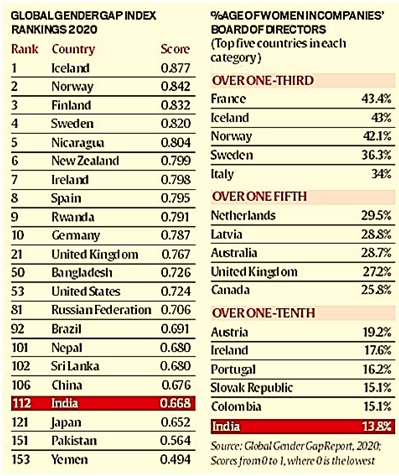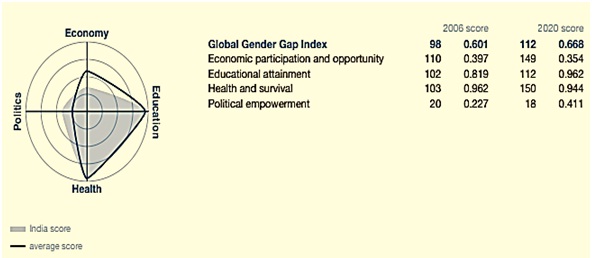Global Gender Gap Index – 2020
- 19 Dec 2019
- On 14th December, 2019, the World Economic Forum (WEF) published the Global Gender Gap Index-2020, which provides a comprehensive overview of the current state of the global gender gap and of efforts and insights to close it.
Aim
- It aims to serve as a compass to track progress on relative gaps between women and men on health, education, economy and politics
About the Index
- The Global Gender Gap Index was first introduced by the WEF in 2006 as a framework for capturing the magnitude of gender-based disparities and tracking their progress over time.
- To be included in the Index, a country must have data available for a minimum of 12 indicators out of the 14 that compose the index.
- The Index has been measuring the extent of gender-based gaps among four key dimensions-
- Economic Participation and Opportunity: It contains three concepts the participation gap, the remuneration gap and the advancement gap.
- Educational Attainment: This captures the gap between women’s and men’s current access to education through ratios of women to men in primary-, secondary- and tertiary-level education.
- Health and Survival: It provides an overview of the differences between women’s and men’s health through the use of two indicators.
- Political Empowerment: It measures the gap between men and women at the highest level of political decision-making through the ratio of women to men in ministerial positions and the ratio of women to men in parliamentary positions.
Key Findings
Global Specific Findings
- Iceland is once again the most gender-equal country in the world for the 11th time in a row.
- Iceland is followed by Norway (2nd), Finland (3rd) and Sweden (4th). Other economies in the top 10 include Nicaragua (5th), New Zealand (6th), Ireland (7th), Spain (8th), Rwanda (9th) and Germany (10th).
- Yemen is ranked the worst (153rd).
- On average, the eight regions assessed by the report have closed between 60.5% (the average score in Middle East and North Africa) and 76.7% (the average score in Western Europe).
- North America is a few percentage points below Western Europe (72.9%) and Latin America and the Caribbean (72.2%) has almost caught up with Eastern Europe and Central Asia (71.3%). They are followed by East Asia and the Pacific (68.5%), Sub-Saharan Africa (68.2%) and South Asia (66.1%).
- Globally, the average (population-weighted) distance completed to parity is at 6%, which is a further improvement since last edition.The political gender gap will take 95 years to close, compared to 107 years last year.
- The largest gender disparity is reported in the Political Empowerment gap. Despite being the most improved dimension this year only 24.7% of the global Political Empowerment gap has been closed in 2020.
- The second-largest gap is on Economic Participation and Opportunity; 57.8% of this gap has been closed so far, which represents a slight step back since last year.

Source: IE
India Specific Findings
- India has been ranked at 112th globally in terms of gender gap,below countries like China (106th), Sri Lanka (102nd), Nepal (101st), Brazil (92nd), Indonesia (85th) and Bangladesh (50th). This slip is attributed to the widening disparity in terms of women’s health and survival and economic participation in the country.
- India has improved to 18th place on political empowerment; it has slipped to 150th on health and survival, to 149th in terms of economic participation and opportunity and to 112th place for educational attainment.

Source: WEF
Significance
- Tool to Track Progress: It provides a comprehensive overview of the current state of the global gender gap and of efforts and insights to close it. The index offers a benchmarking tool to track progress and to reveal best practices across countries and subjects. Through this annual yardstick, stakeholders within each country are able to set priorities relevant in each specific economic, political and cultural context.
- Providing Picture of Country’s Legal and Social Framework: It highlights wide performance variation across countries, which not only allow users to understand how close each country has come to the equality benchmark in each of the four dimensions, but also provide a snapshot of the legal and social framework within which these outcomes are produced.
- Providing Latest Research on Gender Equality:It highlight the strong correlation between a country’s gender gap and its economic performance and summarizes some of the latest research on the case for gender equality.
- Message to Policy-Makers:The report highlights the message to policy-makers that countries that want to remain competitive and inclusive will need to make gender equality a critical part of their nation’s human capital development.\
World Economic Forum
Important Reports Published by WEF
|


